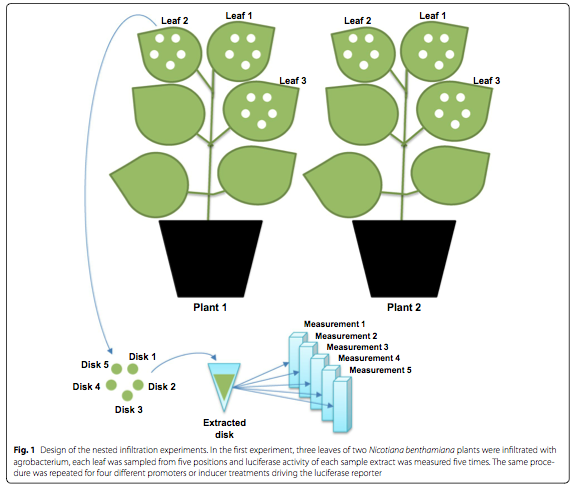Agroinflitration of Nicotiana benthamiana is an increasingly important technique that many plant scientists may use for transient expression of their gene of interest. These experiments might include localisation or interaction studies, monitoring of pathogen effects or simply for protein production where, in extreme cases, up to 50% of the total soluble protein will be expressed by the transgene.
As a previous user of this technique, I know that many aspects of early test experiments can be undertaken haphazardly, with little understanding or expectation regarding the optimum agrobacterium concentration, best leaf segment or inoculation timings to use. There also seems to be significant variation within the same inoculated leaves, between leafs on the same plant and especially so between leaves from different plants. Therefore it is satisfying to read a recent paper published in Plant Methods from the lab of Teemu Teeri (University of Helsinki) that attempts to provide some understanding as to the sources of variation in these infiltration experiments [1].
They conduct a simple set of experiments whereby they use an intron-containing luciferase gene as a reporter to test the factors that most influenced the infiltration efficiency. They inoculated the upper leaves of 6-week old tobacco plants with either luciferase driven by the constitutive 35S promoter or by an estradiol-inducible promoter. They showed that estradiol induced an eight-fold increase in enzyme production and that these induced levels were similar to those observed with the constitutive promoter.
In order to assess variation within experiments they compared samples from the same leaf, between leaves from the same plant and between leaves from different plants. Importantly they used a nested experimental design so that they could compare the amount of variation generated between hierarchical levels of infiltration, sampling or enzyme activity.

Somewhat surprisingly they found that the largest component of variation in these experiments was between disks on the same leaf, whereas use of different leaves or different plants generated a 2.5x lower level of variation. Within disks from a single leaf, the amount of bacteria and protein showed little alteration, even though the luciferase enzyme activity was greatly different. The reason for this difference is unknown.
Therefore based on their results the authors make the following recommendations:
- Ensure tested plants are in the same physiological state.
- Combine the expression values from several sample disks on the same leaf, do not rely on one disk as a representative amount of expression on that leaf.
- Inflitrate more plants but less leaves on those plants. Sample more disks on each of the leaves that are used.
- Technical replicates (for luciferase assays) are not as important since these measurements are more reliable.
Good luck with your experiments!
1- Bashandy et al (2015) Plant Methods11:47 DOI: 10.1186/s13007-015-0091-5




